DISCOVER THE MYSTERIOUS ETRUSCAN CIVILISATION AND MORE, AT TARQUINIA
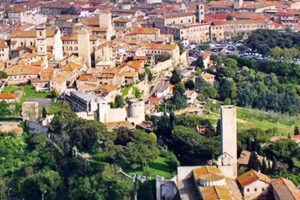
The history of Tarquinia is inextricably connected to the history of the Etruscans. It was here that one of the first settlements of their civilisation arose, made up of a gathering of small groups that clustered together into a complex social structure and formed a city-state. Although little is visible of the once-great wealth and extent of the ancient city, today Tarquinia is famous for its ancient Etruscan tombs in the widespread necropoli, or cemeteries. However, Tarquinia offers so much more. Surrounded by its imposing ancient walls, within the city there are numerous beautiful Romanesque-Gothic churches, a 13th century Palace, and a Baroque priory. Most surprising of all though are the numerous towers, very similar to those found in San Gimignano to its north.
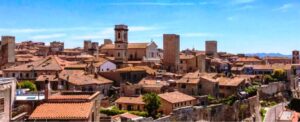
Tarquinia, previously called Corneto since medieval times, is a very old city in the province of Viterbo. In 1922, it was renamed after the ancient city of Tarquinii (Roman) or Tarchuna (Etruscan) under the Fascist Government in Italy as part of the nationalist campaign to evoke past glories. The town is known chiefly for its ancient underground Etruscan tombs located on the edge of today’s town, spread across a huge, very well presented archaeological site. The earliest tomb discovered so far dates from the 7th century BCE, and a number of them can be visited. It’s thought that there are around 6,000 burials, and among these, there are about 200 that contain a series of frescoes.
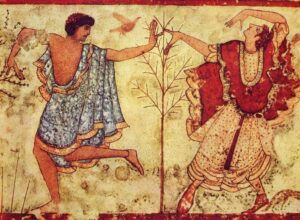
The burial chambers feature frescoed walls with magical and religious scenes, all decorated with intense and lively colours to bring the deceased back to life and help loved ones forget the pain of their loss. Some of the frescoes have been removed from certain tombs in order to protect and conserve them, and these are kept in the National Archaeological Museum of Tarquinia, along with other Etruscan artefacts.
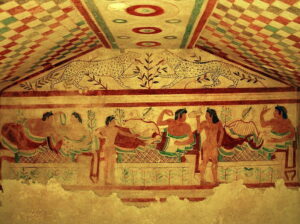
At ‘Calvario’, the portion of the Necropolis open to the public, there are 22 hypogea (underground chambers) currently open to the public, named according to the subject of the frescoes, such as: Tomb of the Jugglers, Tomb of the Warrior, Tomb of the Lotus Flower, Tomb of the Leopards (sometimes mistakenly referred to as lions). The site at Tarquinia is unique in offering an underground picture gallery dating from the so-called Orientalising Period (late 7th century BCE) to the end of the Roman Republican period (mid-1st century BCE).

This gallery of small, individually accessed underground tombs reveals that there was a flourishing and uninterrupted painting tradition in the city, and that this heritage, not only artistic and historical, represents a glimpse into the daily life of the Etruscans. The site has been a UNESCO World Heritage Site since 2004.
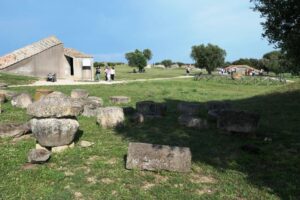
The Necropolis is located on a plateau, and the burial mounds of earth, in the form of small hills, extends parallel to the Tyrrhenian coast for 6 kms in length and about 3 kms in width.
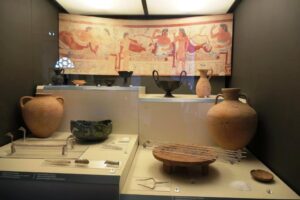
Tarchuna became the most important of the 12 or perhaps more, Etruscan towns which formed a loose confederacy known as the Etruscan League. Very little is known of the League, except that its members had common religious ties and leaders met annually at the Fanum Voltumnae sanctuary near Orvieto—exact location is, as yet, unknown.
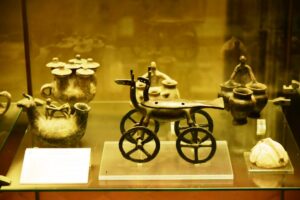
Tarchuna’s prosperity from the 8th century BCE was based on its role as a trade centre and the presence of rich mineral deposits nearby. The surrounding fertile land was put to good use for agriculture, especially the cultivation of olives and vines. Goods were manufactured and exported such as bronze work, gold jewellery and linen. It’s known that there were cultural links with Greece at the time, and a port was established at Gravisca from where goods were exported across the Mediterranean especially with Greek cities, Phoenician traders, and later, Carthage.
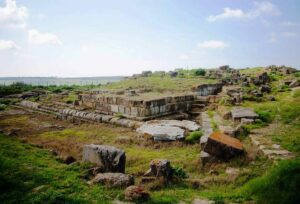
Continuing to flourish in the 6th and 5th centuries BCE, the city constructed large fortification walls, 10kms in total length, and in the 4th century BCE, a temple and impressive chamber tombs.

It’s uncertain exactly when Etruscan Tarchuna came under Roman domination, and its name was changed to Tarquinii. In 181 BC its port, Graviscae (modern Porto Clementino), in an unhealthy position on the coast due to malaria from nearby marshes, became a Roman colonia that exported locally made wine and had coral fisheries. Little is known about Tarquinii in Roman times, but the flax and forests of its extensive territory are mentioned by classical writers, and Tarquinii offered to furnish Scipio (the conqueror of Carthage) with sailcloth in 195 BCE.
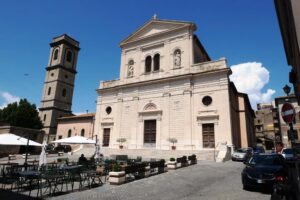
By the early Middle Ages, despite being an Episcopal seat since the 4th century, the ancient city has shrunk to a small, fortified settlement. It eventually gave way to the more strategically placed Corneto, a slightly higher location above the ancient town, which grew progressively to become the major city of the area, especially after the destruction of the port of Centumcellae (modern Civitavecchia). The last historic references to the original Tarquinii are from around 1250, and the last remains were destroyed in 1305.
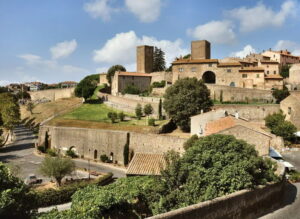
By 1080 Corneto had a fortified palace, now the site of the Church of Santa Maria di Castello, and the perimeter of the fortified walls had been increased. The town became a civitas in the 11th century through a bull of Pope Sergius IV, although it had already been under the influence of the Patrimony of St Peter since 787. During the 12th century, Corneto experienced a political and economic surge through commercial treaties with Pisa, Genoa and Venice. The town’s proximity to the sea and the navigable Marta and Mignone rivers, which had important landings at their mouths, contributed to its growth.
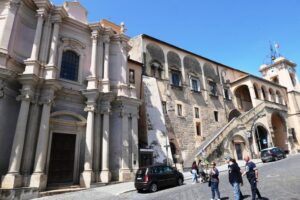
By the mid-12th century, Corneto had become a free municipality, and thus a competitor to Tuscania and Viterbo. A century later, Rome was the best buyer of Corneto’s rich wheat production, which was renowned for its high quality.
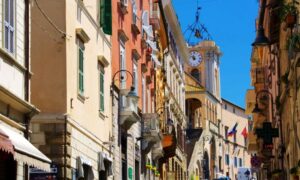
Aside from the extraordinary Etruscan tombs on the outskirts of town, there are many very impressive buildings in Tarquinia, evidence of its rich past.
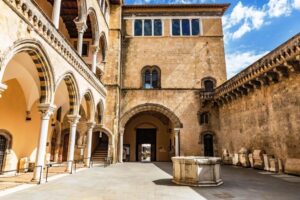
The most important historic building in town is the impressive Palazzo Vitelleschi was built between 1436 and 1439 for the cardinal of Corneto.
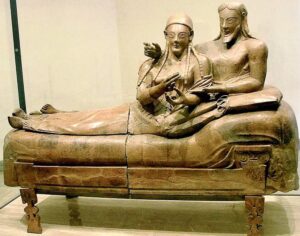
After the Cardinal’s death the palace was used as a stopover for the popes. It changed hands a number of times over the ensuing centuries, and at one time was a hotel. It was acquired by the Italian state in 1916 and opened as a museum in 1924, and now named the National Archaeological Museum. Over time, the museum’s collection was enriched by the numerous finds from the excavations of ancient Tarquinia and the Necropolis of Monterozzi, located on a hill east of Tarquinia, just on the outskirts.

Today, the Palazzo Vitelleschi’s collection is spread over 3 floors. The objects are beautifully displayed and includes sarcophagi—some of which were carved from Greek marble—and date from the 4th century BCE. There is an outstanding collection of pottery, bronze tableware, and other ancient artefacts, some of which originated in Ancient Egypt, Phoenicia and Ancient Greece. In the hall of weapons, the famous “Cavalli Alati”, a pair of winged horses, which decorated the pediment of the pediment of the Ara della Regina temple, are exhibited. The museum’s opening hours change according to the seasons, so check online before you go. Conveniently, you can buy a combined entry ticket for this museum and the Necropolis. The displays in the museum are so informative that they provide the best introduction for a subsequent visit to the nearby tombs.

This is a wonderful museum that’s a pleasure to visit. Its Etruscan treasures are absolutely stunning and beautifully displayed. In our view, it is vastly superior in its presentation to the more famous Etruscan museum in Rome housed in the Villa Giulia. On our last visit a few weeks after being in Tarquinia, we found that to be badly lit (replacing dead light globes would certainly help), objects poorly displayed and too many surfaces in need of a jolly good dusting!
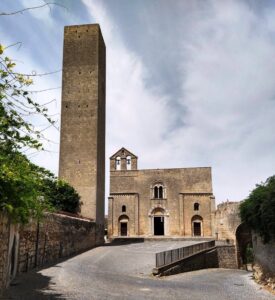
There are an enormous number of important churches scattered throughout Tarquinia, many built in the 12th – 13th centuries. First on a list would have to be the Chiesa di Santa Maria in Castello, thought perhaps to be the oldest church in Tarquinia. A splendid example of Italian Romanesque art, it’s located atop a rocky outcrop on the edge of town. The construction started in 1121, consecrated in 1208, and served as a cathedral until 1435. Adjacent to the church stands a slender medieval tower.
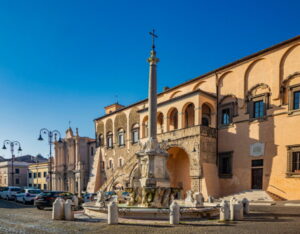
The Town Hall of Corneto dates back to the 13th century and is located on the previous layout of the fortified walls, testifying to the expansion of the town around the churches and convents of the various religious orders that emerged outside the town walls.. Part of the first town walls is the tower located inside the building, dating back to the 10th-11th centuries. The style of the building is predominately in the Romanesque style with some Gothic elements. Despite various interventions and additions over the centuries, the building is still a handsome landmark in the town. One interesting addition during the 16th century that we can still see today, is an iron rod that was embedded into the façade as a unit of measurement for various commodities, to avoid disputes between citizens.

The Palazzo dei Priori is one of the most interesting buildings in the oldest part of Tarquinia’s historic centre. It’s located near the 13th century church of San Pancrazio, and was an ancient administrative seat: austere in appearance, it was built by amalgamating several private buildings. Today, the Palazzo is home to STAS—Società Tarquiniense d’Arte e Storia, as well as the Museo della Ceramica d’Uso a Corneto, where ceramic fragments and materials excavated from the “butti” (rubbish tip) of the Palazzo dei Priori are now displayed that tell the story of the ancient life of the town’s citizens.

One very striking feature of Tarquinia are the number of tall stone towers that still exist. Reminiscent of San Gimignano, those of Tarquinia mostly date from the Medieval era. These towers were relatively common in many medieval Italian cities, although few remain today. They were built by aristocratic and wealthy families to display their power and prestige, and it seems that the higher the tower, the wealthier the family. Although some were observation towers, they served as strongholds for the battles that sometimes took place between various families within the town, as well as part of the town’s defence system against outside threats.
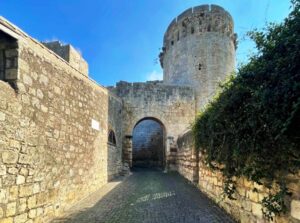
Several towers can be admired within the historic centre of town, such as the imposing rectangular Draghi Tower from the 12th century; the Barucci Tower, which has a crenellated top, the Magistrate’s Tower, characterised by a large, pointed-arch portal; the Dante Tower also known as “della Maddalena” because a church, no longer extant, dedicated to the penitent saint stood next to it; and the Cialdi Tower, located on the northwestern edge of the historic centre, dominating a large green esplanade known as “Campo Cialdi”, the site of events and displays. Another very special tower, built in 1080, is that known as Matilde di Canossa, named after a countess from the area. The tower was restored in 1439 and is flanked by a fortified gate.
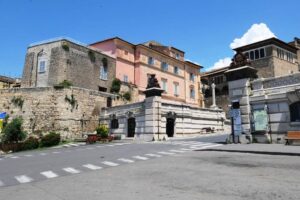
Tarquinia is situated on an elevated position that offers a splendid panoramic view of the coast. The main entrance into the town is by the monumental Barriera San Guisto, built during WWI. It replaced an earlier entrance which was no longer suitable for the urban road system. The entrance features a broad lookout area facing the sea.

You will not only discover over 3,000 years of history in a visit to Tarquinia. This is a bright and lively university town, with a large population of young people that contribute to the town’s vibrant atmosphere. There are good shops and any number of delightful bars and cafes that offer outdoor terraces—some of which are directly opposite the Archaeological Museum. While you’re relaxing in one of the many cafes, take the opportunity to try some of the local wines from Tarquinia. The area produces highly regarded red and white frizzante style wines, mostly made from Sangiovese, Trevviano and Giallo grapes. The town has a range of accommodation, some of which is outside the town on the lower slopes that are also within easy reach of the popular beaches along the coast. The most notable is the Lido di Tarquinia about 5 kms from town, which offers a number of beach clubs with good amenities.

Tarquinia is 18kms north of Civitavecchia, the port of Rome. From Rome, it will take you a little over an hour to drive, or take a train from Rome Termini to Civitavecchia, which takes about 50 mins., and then a 30 min. bus ride from there to Tarquinia.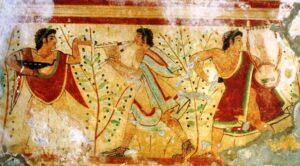
Frescoes of Musicians and Dancers, Etruscan Tombs, Tarquinia


Hi Cheryl
I can’t believe I received your blog.I haven’t read it yetbut I am sure it will be wonderful.
Kind regards
Sandy
Hi Sandy,
Thanks for letting me know you received the latest blog story, and hope you enjoy it when you get time to read it.
Cheers,
Cheryl
As always, absolutely fascinating. Thank you.
Hi Nadine,
Greetings from (very) sunny Paris! So glad you enjoyed the Etruscan story. Such a fascinating civilisation, and still so much to be discovered about them.
Cheers,
Cheryl
Wow! Your research is amazing, than you.
Hi Diane,
Greetings from sunny Paris.
There’s so much to see in Tarquinia, much more than we first realised, since the only thing one hears about are the Etruscan tombs and perhaps the Etruscan museum–virtually nothing about the town itself, so that was such a bonus. Glad you enjoyed the story–I enjoyed exploring the town!
Cheers,
Cheryl
Thank you very much for this interesting blog Cheryl. We have always been intrigued by the Etruscan civilisation- especially their magnificent pottery and art. What a special town to visit!
Have a wonderful time in sunny gorgeous Paris!
Best wishes
Jenny and Don
Hi Jenny and Don,
We too had been very interested in the rather mysterious Etruscans, and Tarquinia had long been on our “must visit” list. So much more though to the town, making it a very worthwhile destination. The Etruscan museum is wonderful. By the time we got to Rome a week later, a visit to the Etruscan Museum there was on our list–somehow, we’d never been there before. What a contrast with the Tarquinia museum, as I mentioned. One of the best Etruscan exhibitions we’ve ever seen was in Bologna a few years ago, which had gathered up beautiful objects and artefacts from a number of public and private collections. An intriguing culture indeed.
Glad you enjoyed the story!
Cheryl